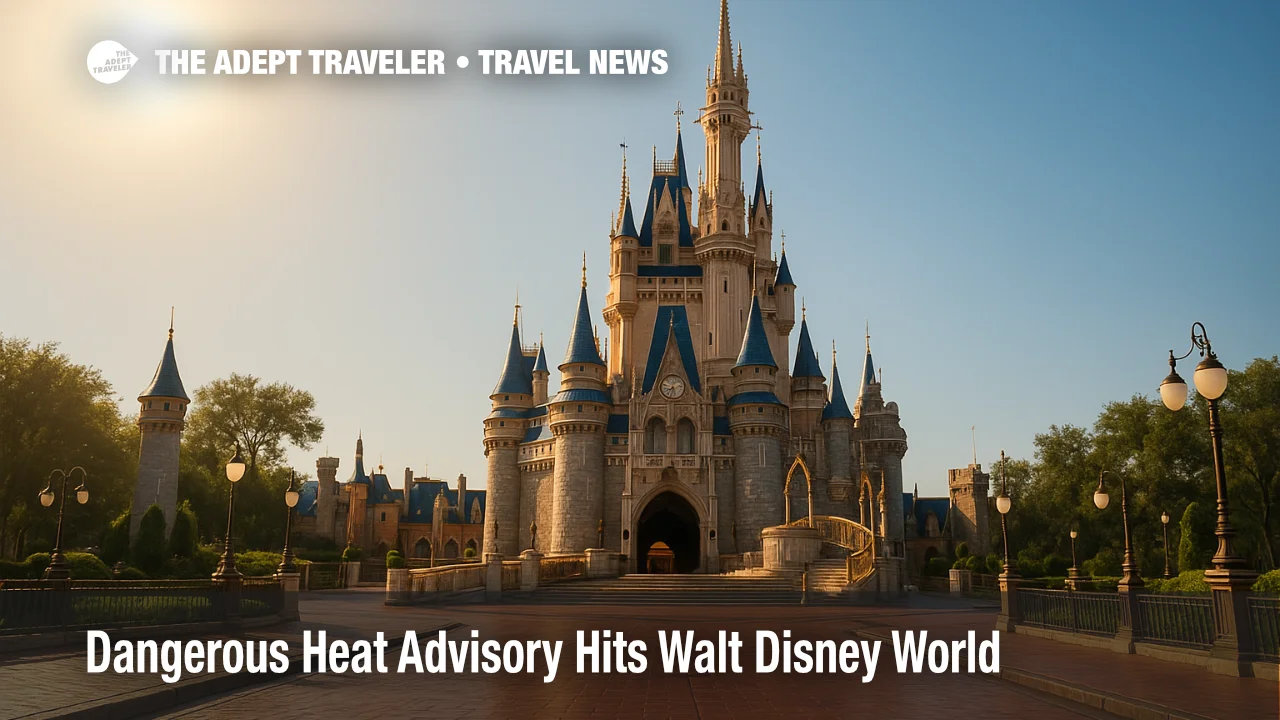Dangerous Heat Advisory Hits Walt Disney World

Central Florida's already-steamy summer is turning perilous this week. Forecasters say Walt Disney World and the greater Orlando area will roast under a Level 3-4 HeatRisk through at least Friday, with actual highs near 99 °F and sultry humidity pushing afternoon heat indexes to a brutal 112 °F. A National Weather Service Heat Advisory is in force today from noon to 7 p.m., the first in what could be a multiday streak if nighttime temperatures remain stubbornly high. Travelers headed for the parks should prepare for relentless sun, limited overnight relief, and the possibility of additional advisories as the week drags on.
Key Points
- Why it matters: Prolonged Level 3-4 HeatRisk can trigger heat illness in anyone, not just sensitive groups.
- Heat index may peak at 106 - 112 °F each afternoon, exceeding normal July values.
- Advisory covers all four Disney parks, plus Universal Orlando, SeaWorld, and nearby resorts.
- Hydration, midday breaks, and lightweight clothing are essential; shade alone is not enough.
- No cooling trend appears in forecast models before the weekend.
Snapshot
Visitors arriving this week will confront oppressive daytime highs of 97 - 99 °F, accompanied by dew-point readings above 75 °F that drive "feels-like" numbers well past 110 °F. The National Weather Service in Melbourne expects only marginal overnight cooldowns into the upper 70s, keeping bodies under stress even at dawn. In these conditions, unshaded queuing areas and slow-moving attraction lines can become hazardous in less than 30 minutes. The agency urges guests to drink water steadily, use re-entry privileges for hotel or vehicle breaks, and watch for cramps, dizziness, or confusion, early signs of heat exhaustion.
Background
Florida's interior routinely posts some of the hottest summer readings in the Southeast, but 2025 has stacked heat weeks without the usual pattern of afternoon storms to vent the swampy air. According to climate normals, Orlando averages nine July days above 95 °F; this week alone could equal that. Local hospitals saw heat-related ER visits spike during last July's shorter hot spell, underscoring the risk for out-of-state travelers unaccustomed to Florida's humidity. The HeatRisk scale-jointly developed by NOAA and CDC-flags Level 3 as "Major" and Level 4 as "Extreme," warning that even healthy adults face danger without proactive cooling.
Latest Developments
NWS Extends Multi-Day Heat Advisory Window
Meteorologists in Melbourne caution that today's advisory "likely will not be the last." Model consensus shows heat indexes topping 108 °F each afternoon through Friday, especially west of Interstate 95 where sea-breeze relief lags. Additional bulletins could cover Tuesday and Wednesday if overnight lows stay above 77 °F, a key trigger for repeat advisories. Travelers should monitor official alerts on the NWS Heat.gov portal or local weather apps for real-time updates.
Analysis
String-after-string of high-pressure domes has shifted Florida's summertime thunderstorm timing later in the evening, reducing the midday cloud shields that normally cap temperatures. For theme-park patrons, that means longer exposure in paved environments where heat radiates upward, erasing any breeze benefits. While parks offer free ice water at quick-service counters and misting fans in some queues, guest behavior remains the wild card. Vacationers often push to "do it all," skipping meals or hydration to save time-precisely the misstep that accelerates heat stress. Medical teams on property report that children and older adults seeking shade too late are frequent cases. Expect walk-through character meet-and-greets to move indoors and some parades to shorten routes if pavement temperatures exceed safety thresholds. Even evening fireworks may feel stifling, as 9 p.m. readings could still hover above 88 °F with a heat index near 95 °F. The best defense remains a flexible itinerary: rope-drop early, retreat to an air-conditioned hotel at midday, then return after 6 p.m., a pattern many Orlando veterans embrace.
Final Thoughts
The oppressive spell underscores that Walt Disney World heat advisory periods are no longer rare outliers but a growing reality of Central Florida summers. Travelers who build hydration stops, midday breaks, and weather-aware planning into their itineraries will safeguard both magic and well-being as the mercury soars.
